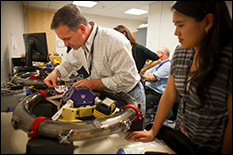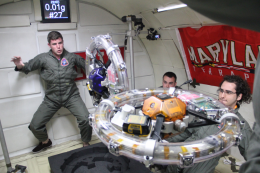New technology could revolutionize satellite use

(Phys.org) —New technology being tested by the University of Maryland's Space Power and Propulsion Laboratory (SPPL) on the International Space Station could revolutionize the capabilities of satellites and future spacecraft by extending their lifecycle through the use of a renewable power source.
Finite storage for propellants—a chemical used in the production of energy—is often the limiting factor on the number of times a satellite can be moved or repositioned in space. However, a new propulsion method that uses a renewable, onboard electromagnetic power source, and does not rely on propellants, could exponentially extend a satellite's useful life span and provide greater scientific return on investment.
Ray Sedwick, associate professor of aerospace engineering at UMD, and his research team have been developing technology that could enable electromagnetic formation flight (EMFF), which means using locally generated electromagnetic forces to position satellites or spacecraft without relying on propellants. Magnetic forces and torques are generated by circulating electrical current through a coil attached to each vehicle which can be used to reorient the satellites relative to one another. Their research project is titled Resonant Inductive Near-field Generation System, or RINGS.
RINGS was sent to the International Space Station on August 3 on a Japanese resupply spacecraft and is scheduled for four test sessions on the research station. Astronauts will unpack the equipment, integrate it into the test environment and run diagnostics. From there, RINGS will undergo three science research sessions where data will be collected and transmitted back to the ground for analysis.

In the spring of 2013, RINGS was tested for the first time in a microgravity environment on NASA's reduced gravity aircraft. UMD graduate students Allison Porter and Dustin Alinger were on hand to oversee the testing. RINGS achieved the first and only successful demonstration of EMFF in full six degrees of freedom to date.
"While reduced gravity flights can only provide short, 15-20 second tests at a time, the cumulative test time over the four-day campaign provided extremely valuable data that will allow us to really get the most from the test sessions that we'll have on the International Space Station," said Sedwick.
In addition to EMFF, the RINGS project is also being used to test a second technology demonstrating wireless power transfer (WPT). WPT may offer a means to wirelessly transfer power between spacecraft and in turn power a fleet of smaller vessels or satellites.
More information: Space Power and Propulsion Laboratory
Provided by University of Maryland



















